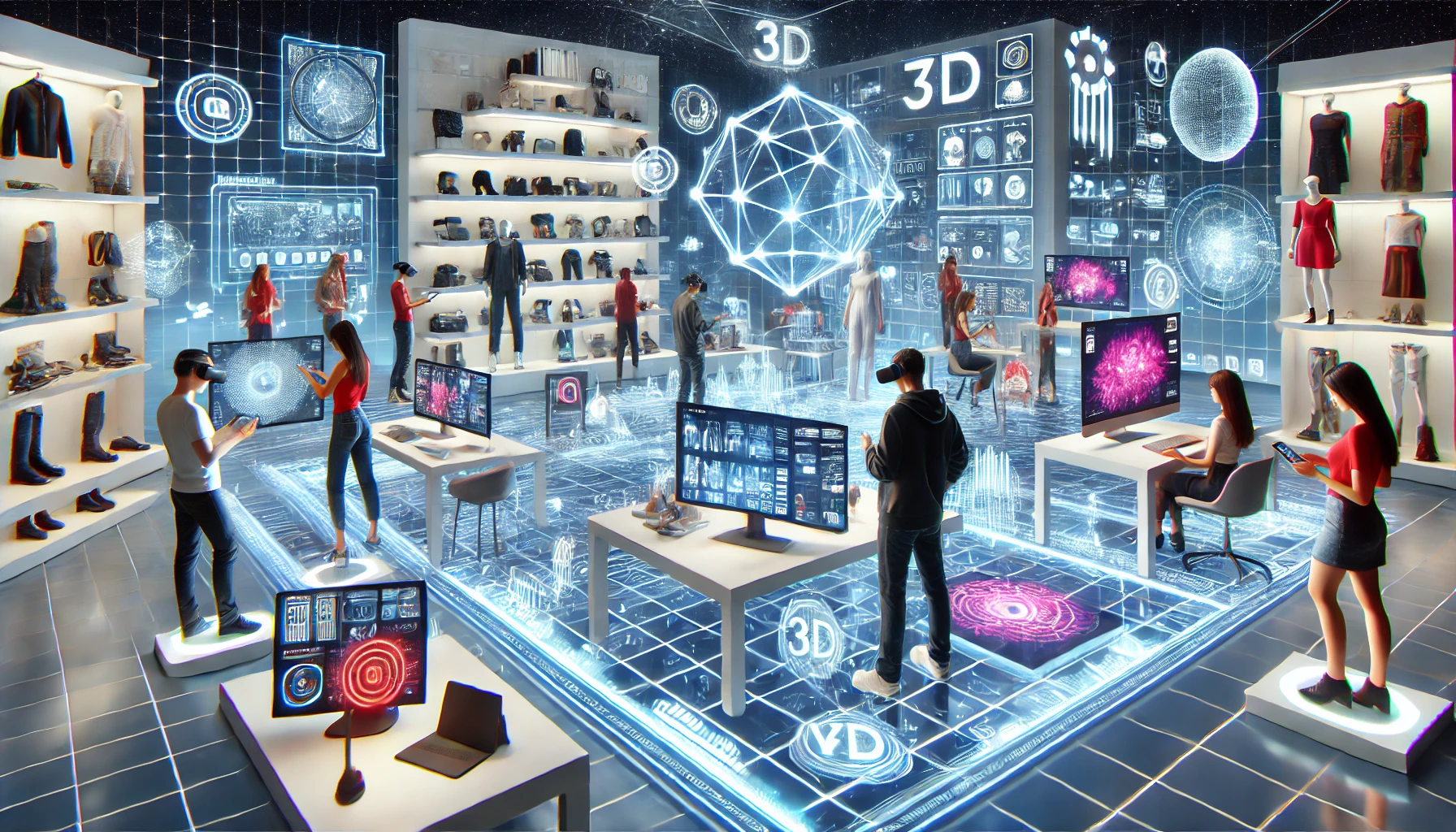As digital landscapes evolve, so does the way consumers interact with brands and products. The traditional boundaries of online shopping are rapidly expanding, ushering in an era of 3D metacommerce. This emerging concept leverages the immersive power of 3D technology and the connectivity of the metaverse, offering retailers the chance to enhance customer experiences, build deeper engagement, and elevate e-commerce to an entirely new level. But what exactly is a 3D metacommerce platform, and how can it transform the retail sector in the future?
What is 3D Metacommerce?
3D metacommerce refers to a digital platform where consumers can interact with products in three-dimensional, immersive environments, often facilitated by the metaverse. In contrast to traditional e-commerce, where customers view products on a flat screen, 3D metacommerce introduces them to an interactive, hyper-realistic shopping experience within virtual spaces. This allows users to not only see products in 3D but also manipulate them, examine them from all angles, and even simulate their use or placement in real life.
The integration of metaverse technologies amplifies these capabilities by offering persistent virtual worlds where users can socialize, shop, and experience brands in ways that were previously unimaginable. Retailers using 3D metacommerce platforms can create customized, branded spaces within the metaverse, offering consumers an entirely immersive shopping journey.
The Core Elements of a 3D Metacommerce Platform
The potential of 3D metacommerce lies in the synergy of its core elements:
- 3D Visualization and Product Interaction: Detailed, high-quality 3D models of products allow customers to engage with items as if they were physically present. Features like zoom, rotation, and real-time customizations (such as color or material changes) make the experience tactile and personal.
- Augmented and Virtual Reality (AR/VR): To fully harness the power of the metaverse, 3D metacommerce platforms are often compatible with AR and VR technology. Shoppers can wear VR headsets to step into virtual stores or use AR on mobile devices to preview how products would look in their home or on themselves.
- Social Shopping Experiences: The metaverse isn’t just a solitary experience. 3D metacommerce platforms allow for social interactions where users can shop with friends or engage with brand ambassadors in real-time. This social commerce element enhances trust, builds community, and fosters user-generated content.
- Blockchain and NFTs: In the metaverse, ownership can extend to digital assets like NFTs (non-fungible tokens). Brands can release limited-edition digital products or collectibles, creating a sense of exclusivity and enabling customers to purchase virtual versions of physical items.
- Seamless E-commerce Integration: To ensure a smooth transition between browsing and buying, 3D metacommerce platforms must integrate directly with e-commerce backend systems, allowing for inventory tracking, secure payments, and shipping options without leaving the virtual environment.
How 3D Metacommerce Benefits Retailers and Shoppers
The promise of 3D metacommerce for retail goes beyond just a novel experience. It has the potential to drive revenue, increase engagement, and reshape how brands build relationships with their customers.
- Enhanced Customer Engagement and Satisfaction In traditional e-commerce, customers are limited to images and descriptions, often resulting in uncertainties about how a product will look or feel in real life. With 3D metacommerce, shoppers gain a comprehensive view of products, reducing guesswork and increasing purchase confidence. Retailers benefit from fewer returns due to increased transparency, leading to happier customers and lower logistical costs.
- Data-Driven Personalization 3D metacommerce platforms provide a wealth of data about customer behavior in virtual spaces. For instance, retailers can track which products customers spend the most time with, where they explore within a virtual store, and even social interactions with others. This data enables precise personalization, offering targeted recommendations and promotions based on real-time user behavior.
- Deeper Brand Connection Through Immersive Storytelling The metaverse allows brands to showcase their identities and values in creative ways. For example, a sustainable brand might build a virtual forest where customers can shop among trees and learn about the brand’s eco-friendly practices. By creating branded spaces, companies can make a lasting impression and communicate their mission in a manner that resonates deeply with customers.
- Community Building and Social Shopping 3D metacommerce platforms facilitate community engagement by allowing customers to shop with friends or interact with brand ambassadors in real time. Imagine a virtual store where customers can ask questions to an AI-powered brand representative or browse alongside friends, getting real-time feedback. This social shopping model adds a layer of interaction that traditional e-commerce lacks, fostering a sense of community and increasing word-of-mouth marketing.
- A New Revenue Stream Through Digital Assets and NFTs NFTs have introduced a digital economy within the metaverse. For retailers, this opens up possibilities for new revenue streams. Brands can sell virtual goods, limited-edition NFTs, or metaverse-exclusive products that customers can use to customize their avatars or virtual spaces. In fashion retail, for instance, a luxury brand could offer digital garments as NFTs that customers can “wear” within metaverse environments, adding exclusivity and appeal to their offerings.
- Global Reach Without Physical Limitations 3D metacommerce platforms make it possible for brands to reach global audiences without setting up physical stores. Customers can visit virtual spaces from anywhere in the world, allowing retailers to expand their market reach. This model is especially advantageous for smaller brands or startups that wish to scale quickly and reach new markets.
- Better Environmental Impact Unlike physical stores, which require energy, space, and significant resources, virtual stores are more eco-friendly. By shifting parts of their business to the metaverse, retailers can reduce their environmental footprint. The 3D models themselves may require energy for rendering and hosting, but this impact is considerably lower than the physical manufacturing and transport processes associated with traditional brick-and-mortar retail.
Challenges and Considerations
While 3D metacommerce promises significant advantages, there are challenges to consider:
- Accessibility and Device Compatibility: While VR and AR devices enhance the experience, not all consumers own them. Ensuring that platforms are accessible on standard devices like mobile phones or computers is crucial for mass adoption.
- Technical Expertise and Development Costs: Building 3D environments and creating realistic product models require advanced technical skills and resources. Retailers must consider initial investments and maintenance costs in developing their 3D metacommerce presence.
- Privacy and Data Security: Gathering customer data in virtual environments can raise concerns about privacy. Retailers will need to prioritize transparent data practices and robust security to protect customer information.
- Continuous Innovation: The metaverse and 3D technologies are evolving rapidly, and brands need to stay agile, adapting to new trends and technologies to remain competitive.
The Future of Retail in the Age of 3D Metacommerce
The 3D metacommerce platform represents a radical shift in how retailers will approach digital interactions, sales, and branding. As more companies experiment with these immersive platforms, customer expectations for online shopping will continue to evolve, favoring immersive and interactive experiences over flat, static ones. With time, 3D metacommerce will become a standard part of the retail landscape, enabling brands to break free from the limitations of traditional e-commerce and build deeper connections with their customers.
The metaverse itself will likely grow in complexity, offering enhanced graphics, better accessibility, and more robust integration with physical and digital products. Retailers that embrace 3D metacommerce early stand to gain a competitive edge by positioning themselves as innovative, customer-centric brands.
In conclusion, 3D metacommerce is more than just a trend; it’s a transformative force poised to redefine retail as we know it. By bridging the gap between digital and physical realities, 3D metacommerce will open new avenues for customer engagement, personalization, and brand loyalty, setting the stage for the future of e-commerce in the age of the metaverse.




